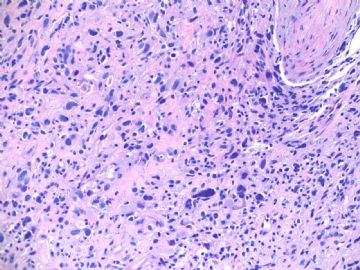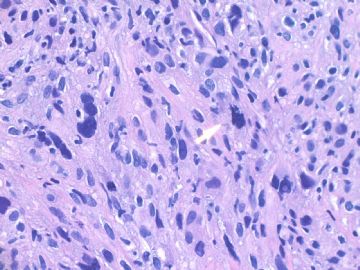| 图片: | |
|---|---|
| 名称: | |
| 描述: | |
- B1803少见乳腺肿物,鉴别诊断? (cqz-18, 5-7-2009)
| 姓 名: | ××× | 性别: | 年龄: | ||
| 标本名称: | |||||
| 简要病史: | |||||
| 肉眼检查: | |||||
about 60 y/f, right breast mass 2 cm by imaging, breast core biopsy.
1. Your differential diagnosis?
2. What will you do next?
Please do not just give a diagnosis. Your dx is a guess dx even though your diagnosis may be right.
As pathologists we should learn how to analyse our cases with logic thought.We should have differential dx for all cases in our mind even for the easy cases. We can use available sources (such as IHC, molecular methods, history, consultation) to rule in or rule out the differential dx, then make the final dx.
Learning the priniciple for diagnosis is much more important than learning a few cases.
-
本帖最后由 于 2009-05-07 18:28:00 编辑
相关帖子
-
Ann Surg Oncol. 1998 Oct-Nov;5(7):635-41.
-
Primary leiomyosarcoma of bone: clinicopathologic, immunohistochemical, and molecular biologic aspects.
Department of Trauma, Hand and Reconstructive Surgery, University of Saarland, Homburg, Germany.
BACKGROUND: Primary leiomyosarcoma of bone is a very rare malignant tumor with uncertain pathogenicity. METHODS: The authors studied five cases of surgically treated primary leiomyosarcoma of bone. Clinical histories and radiographic findings were recorded. Regular clinical and radiographic controls were obtained postoperatively. In all cases, immunohistochemical studies were used to confirm the diagnosis. Molecular biologic examinations, using the polymerase chain reaction technique with microsatellite DNA markers from regions of tumor-relevant genes, were performed to determine the stability of the genome or to detect some typical genomic changes. RESULTS: The study included three women and two men, with an average age of 42 years. The tumor was located in the pelvis in two patients, in the femur in two patients, and in the proximal tibia in one patient. All tumors were classified as high-grade tumors (four stage IIB, one stage IIA). Radiographically, all tumors appear as purely osteolytic lesions, with a geographic or moth-eaten appearance and without any sclerotic margin. Three patients underwent limb salvage surgery followed by endoprosthetic replacement. The other two patients required amputation. The mean follow-up was 19 months (range, 8-29 months). Three patients died of disease, with a mean postoperative survival period of 18 months (range, 6-27 months). Four patients developed diffuse pulmonary metastases after an average of 10.5 months. One of those patients responded well to chemotherapy. In all cases, immunohistochemistry showed strong reactivity of the tumor cells for (alpha-SMA and vimentin. Molecular biologic investigations revealed a high rate of genomic instabilities in all of the stage IIB tumors. CONCLUSION: Clinical follow-up suggests that primary osseous leiomyosarcoma has an aggressive biologic behavior. The immunohistochemical studies are useful tools and suggest that osseous leiomyosarcoma arise from the vascular smooth muscle cells within the bone. The molecular biologic findings of a high rate of genomic instability confirm the hypothesis that this rare entity is of an aggressive nature.
-
Am J Surg Pathol. 1997 Nov;21(11):1281-94.
-
Primary leiomyosarcoma of bone: a clinicopathologic, immunohistochemical, and ultrastructural study of 33 patients and a literature review.
Department of Pathology, Memorial Sloan-Kettering Cancer Center, New York, New York 10021, USA.
Leiomyosarcoma of bone is a rare tumor in an unusual location. Previous analysis of this entity mostly involved small numbers of cases with limited follow-up. Thirty-three patients with leiomyosarcoma of bone between 1977 and 1996 were studied, and the histologic appearance and grade were correlated with subsequent treatment and clinical behavior. To be included in this study the tumor had to be intraosseous, with other primary sites of origin clinically excluded. Also, most of the sarcomatous tissue (> or =70%) had to be of intramedullary location with only limited extraosseous extension. The patient's age at diagnosis ranged from 13 to 77 years (average 44.4). The gender distribution was equal. The long bones were preferentially affected (64%), with the lower extremity, around the knee joint, predominantly involved. Five patients (15%) developed postradiation leiomyosarcomas. The histologic analysis showed that the osseous leiomyosarcomas are most commonly of the classic type, followed by the epithelioid, myxoid, and pleomorphic variants. Immunoreactivity for smooth muscle markers (smooth muscle actin, common muscle actin, desmin) was positive in all tumors, and ultrastructural confirmation was obtained in 21% of cases. All sarcomas were histologically graded, which accurately reflected the subsequent prognosis. Seventy-five percent of the lesions were high-grade and the rest low-grade. The histologic grade of the tumors correlated with both the recurrence as well as the metastatic rates and together with the clinicopathologic stage of disease represented the cornerstone on which prudent therapy should be based.
-
本帖最后由 于 2009-05-30 19:28:00 编辑
Primary leiomyosarcoma of the bone is very rare also. The above paper may be the largest study.
Memorial Sloan-Kettering Cancer Center, New York is the largest cancer center in the USA.
Pathology dx is not difficult with IHC, but you need to think about this lesion.
Thank 笃 (du)行者 to share the bone tumor here.
-
zezexiaozi 离线
- 帖子:16
- 粉蓝豆:60
- 经验:313
- 注册时间:2009-06-02
- 加关注 | 发消息
| 以下是引用在路上在2009-6-3 23:35:00的发言: 如果我遇到这样的病例,我的第一印象是:梭形细胞化生性癌---可以用CK7、CK8/18等确定其上皮性质;周围可能有原位癌成分;另外,梭形细胞癌也常标记肌上皮标记物(如P63、S-100、calponin等故需注意与肌上皮癌鉴别)。 当然一定要有其他鉴别诊断:1、恶性叶状肿瘤---寻找良性上皮成分;梭形细胞CK阴性而Vimentin阳性;或可有异源性分化(如骨、肌源性分化等)。2、乳腺间质肉瘤。3、乳腺非特异性软组织肉瘤。…… 期待Dr.zhao的结果与分 第一考虑梭形细胞化生性癌 |
Doctor,
Your analysis is very good. I will be more happy if you could spend a little time to read people's discussion and IHC photos.
























